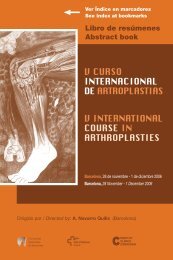Notas / Notes - Active Congress.......
Notas / Notes - Active Congress.......
Notas / Notes - Active Congress.......
Create successful ePaper yourself
Turn your PDF publications into a flip-book with our unique Google optimized e-Paper software.
MIÉRCOLES / WEDNESDAY<br />
58<br />
placement, and employing the combined anteversion method,<br />
the occurrence of impingement should significantly be reduced<br />
and this will improve the immediate and long-term results<br />
for total hip replacement.<br />
Fewer studies have explored femoral component malposition<br />
than acetabular component malposition. Femoral malposition<br />
is thought to be more easily avoidable intraoperatively, and<br />
is more difficult to assess postoperatively by standard radiographs.<br />
McCollum& Gray thought the orientation of the femoral<br />
component as less critical and less complex than the<br />
orientation of the acetabular component. It was believed that<br />
the femoral anteversion can always be controlled to the desired<br />
position of 10-15 degrees. Surgeons therefore implant<br />
the acetabular cup targeting a fixed angle of anteversion based<br />
on the assumed femoral anteversion.<br />
The surgeon can control the amount of anteversion of a cemented<br />
stem but not of a noncemented stem. Anteversion<br />
of cemented stems can be controlled by the surgeon because<br />
a stem with a diameter smaller than that of the medullary<br />
canal of the femur can be used and can be inserted into 15<br />
+/- 5 degrees of anteversion while being fixed with cement.<br />
The surgeon has much less ability to control anteversion of<br />
a cementless femoral stem because the rigid metal stem<br />
must be fit into a specific geometric shape of the femur. The<br />
anterior bow of the femoral diaphysis, which can be as much<br />
as 10 degrees, influences the anteversion of the pros-thetic<br />
stem. Anteversion has been found to show an inverse relationship<br />
with the degree of femoral bowing.<br />
D’Lima et al., in their finite-element study found the femur<br />
has variable anteversion of the neck and variable anterior<br />
diaphyseal bowing, both of which influence the anteversion<br />
of the prosthetic neck in relation to the femoral axis. With<br />
use of postoperative computed tomography scans, Wines<br />
and McNicol, with both cemented and cementless stems,<br />
found a range of 15 degrees of retroversion to 45 degrees<br />
of anteversion (mean of 16.8 degrees) and Pierchon et al.,<br />
with cemented stems, reported a similar observation with<br />
range of 30 degrees of retroversion to 37 degrees of anteversion<br />
(mean of 16.5 degrees).<br />
In our institute, using imageless computer navigation, we<br />
found a mean of 9 degrees of anteversion of the femoral<br />
stem in men and a mean of 19 degrees in women. Our finding<br />
is similar to that of Maruyama et al. who measured intact<br />
cadaver femora to have a mean anteversion if 9.8<br />
degrees. In our patients, cementless stem position is between<br />
10-20 degrees anteversion in only 43% of hips; 10% are in<br />
absolute retroversion; 42% between 0-9 degrees anteversion;<br />
and 5% have more than 20 degrees anteversion. The mean<br />
anteversion for cementless stems was 8-10 degrees. This<br />
data means that there is the potential for cementless stem<br />
anteversion to be 15 degrees different than the anticipated<br />
position of 15 degrees anteversion. Therefore, the risk exists<br />
that the stem may have an outlier of 10 degrees, and if the<br />
cup does too, the combined anteversion could be 20 degrees<br />
than anticipated.<br />
Ranawat taught a ‘manual combined anteversion test for total<br />
hip replacement since the early 1990s. According to him,<br />
with the cup and stem in place, the lower limb is positioned<br />
in neutral (or slight hip flexion) and is internally rotated until<br />
the femoral head is symmetrically seated (coplanar) in the<br />
cup. The combined anteversion is the amount of internal rotation<br />
in degrees needed to produce a coplanar head and cup.<br />
Ranawat and Maynard recommended a combined anteversion<br />
of approximately 45 degrees in female patients, and 20 degrees<br />
to 30 degrees in male patients. McKibbin defined the<br />
stability index for anatomic hips to be 30 degrees to 40<br />
degrees, with a range of 20 degrees to 35 degrees for men<br />
and 30 degrees to 45 degrees for women. A combined anteversion<br />
of





